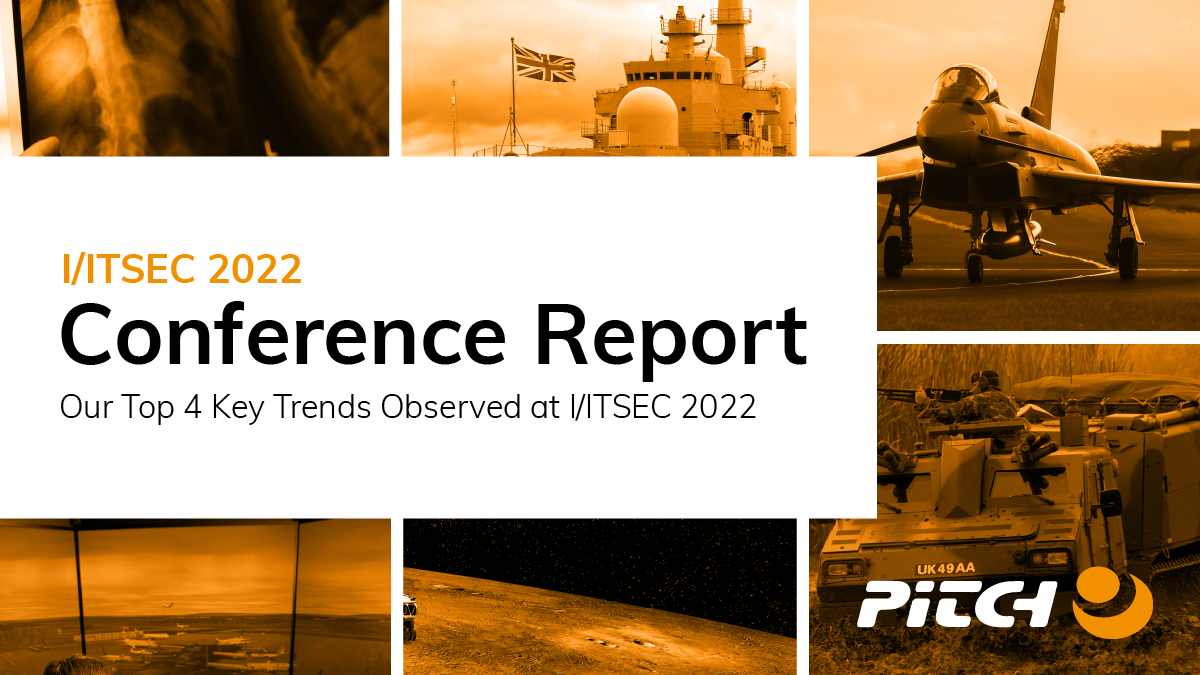With the jetlag slowly leaving body and mind it is time to reflect on another successful and fun I/ITSEC. After a week filled of discussions with customers, partners, and friends in the community a few themes have made themselves apparent. In this conference report, we discuss some of the trends of the ModSim Industry observed at I/ITSEC 2022.
1. The future of training is multi-domain, multi-national, and multi-level
Recent conflicts have demonstrated that the modern battlefield requires dynamic and tightly integrated operations between all arms; Air, Land, Maritime, Cyber and Space; to achieve success. The only true way to prepare for this modern theatre of war is to train as you fight. As a consequence, the requirement for future training capabilities to interoperate with new and legacy systems has never been greater.
For the field of simulation, we have seen a clear increase and interest in multi-domain, multi-national, and multi-level exercises. To meet this demand, we believe the industry must continue to build upon existing infrastructure, providing robust and scalable platforms for integrating new and emerging technologies. Only then can we meet the demands of scale and complexity of future training operation.
Multi-domain integration also presents us with some unique challenges. Maintaining data integrity and controlling data release between systems will require advanced Cross Domain Security solutions.
2. XR is Everywhere – Is This the Metaverse?
Just about every other stand at the show floor contained VR or AR headsets integrated in the demonstrations. At the same time, there is still plenty of dome projection systems on offer. The choice between VR/AR headsets and dome systems comes down to the training need (level of immersion, fidelity, practicality) and cost.
What XR really has brought to the table is the ability to offer good-enough immersiveness at a cost available for the masses. On the downside we have the infamous XR-sickness that still limits deployment to a wider audience, but new technology promises to sort this out.
For many cases, we expect to see an increased use of XR-applications. As a sprinkle on top, the discussion of the Military Metaverse intensifies. What is it? What will it be? Still to be decided, but XR is a key pillar. We think.
3. Commercial Game Engines Making Further Inroads
After a week filled with press releases from the Unreal Engine team there can only be one conclusion: The commercial game engines have garnered interest from many new and traditional simulation systems developers looking to build the next generation of simulation-based training systems and digital twins.
Over 60 companies on the show floor utilized UE in their demos and major simulation providers such as CAE, Lockheed Martin, and Thales announced their intention to pivot their future development into the Unreal ecosystem. We also saw a number of exhibitors demonstrating 3D visualizations based on the Unity game engine.
Integration of commercial gaming technologies within simulation will undoubtedly bring a new level of capabilities, but also a set of new challenges to the community. Read more on our thoughts on the topic in this paper.
4. Open Standards Are More Important Than Ever
It can’t really be a Pitch conference report without mentioning open standards, right? When it comes to creating multi-dimensional exercises and adopting new technologies such as commercial game engines and XR, interoperability will remain crucial. And as has been proven time and time again, Open Standards is the way to go to provide jointly defined and understood interfaces of cooperation.
With recent examples such as the VIKING 22 exercise and the RAF Gladiator program under our belt, we are confident to say that the use of Open Standards in general, and HLA in particular, has proven its capability to deliver at scale. Both of these systems also incorporate the Pitch CDS Gateway product to connect simulators over both organisational and national boundaries.
As ever, we saw the true measure of community interest in Open Standards when all the venues filled beyond capacity for the Pitch Interoperability Evening, HLA-introduction tutorial by Bjorn Moller, the LVC Interoperability 101 tutorial by Damon Curry, and the SISO-discussion on Open Standards with Bjorn Lofstrand.
What’s Next for Pitch?
As a sustaining NTSA-member we can proudly announce that Pitch has already signed up for I/ITSEC 2023. Next year we will make slight relocation from our usual position to booth 1281, together with an exciting overhaul of our booth layout. More to come on that later. But even though some things will change, one thing always remain: Pitch is still committed to serving the best espresso of the show floor.
That is it for I/ITSEC 2022. We hope you enjoyed this conference report. Feel free to reach out with questions or thoughts. In the meantime, we look forward to seeing you at one of our upcoming conferences:
- SISO-SIW, February 13-17, 2022, Orlando, USA
- SpaceCom Conference, February 21-23 2023, Orlando, USA
- ITEC, 24-26 April 2023 in Rotterdam, the Netherlands
- DSET, 5 – 8 June 2023, Bristol, UK

